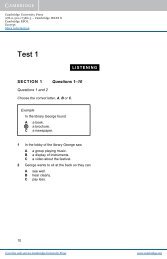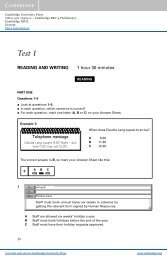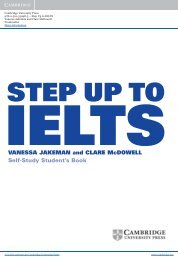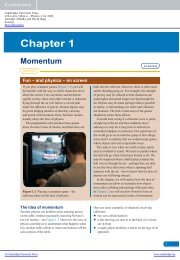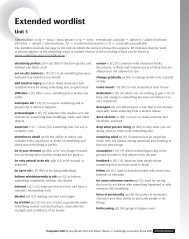Skills for Study Level 2 Teacher's Book - Cambridge University Press
Skills for Study Level 2 Teacher's Book - Cambridge University Press
Skills for Study Level 2 Teacher's Book - Cambridge University Press
You also want an ePaper? Increase the reach of your titles
YUMPU automatically turns print PDFs into web optimized ePapers that Google loves.
Suggested answersGraphic Strengths WeaknessesBar chartTableLine graphPie chartScatterplotUseful <strong>for</strong> showingmain trends andcomparing in<strong>for</strong>mationin different categories.Can show a lot ofprecise, detailed data,there<strong>for</strong>e it is oftenclaimed that tablesare best <strong>for</strong> analysis ofdata.Useful <strong>for</strong> showingchanges over time.Useful <strong>for</strong> showingchanges inquantitative data.Allows an easycomparison ofproportional data.Helps reader tovisualize a basicfeature of data.Good <strong>for</strong> showing arelationship betweentwo numericalvariables.There’s a limit to the number ofbars that can be presented be<strong>for</strong>eit becomes difficult to compare thedata in the bars.Using stacked or 3D bar chartscan make it difficult <strong>for</strong> a viewer toperceive the data accurately.It can be difficult to spot maintrends in data when presented in atable.Little impact if the change is small.Little use if the number of readingson x axis is small.Can only represent a very limitedamount of data.Not good <strong>for</strong> detailed analysis of thedata – studies show that people tendto be unable to accurately judgethe numerical value of pie chartsegments (all the more so if it’s a 3Drendering).Needs a large amount of data toeffectively communicate a trend.Unit Task: The gender gapIn groups of 3–4, students hold a discussion about different aspects of their chosenassignment title. In order to help focus the discussion, supplementary questionsare given <strong>for</strong> each separate title. No suggested answers are given here as studentsare encouraged to draw their own conclusions, supported by the data they havediscovered on the topic.Note: Ask students to turn to the checklist on p.241 and reread the tips relating toUnit 1 Parts A–C, be<strong>for</strong>e reading the tips to Unit 1 Part D. Encourage students to putthese tips into practice in their studies from now on. Tell them they will be asked toreport back on this in a future lesson.Unit 1 Part D ∙ Reporting in speech 30






